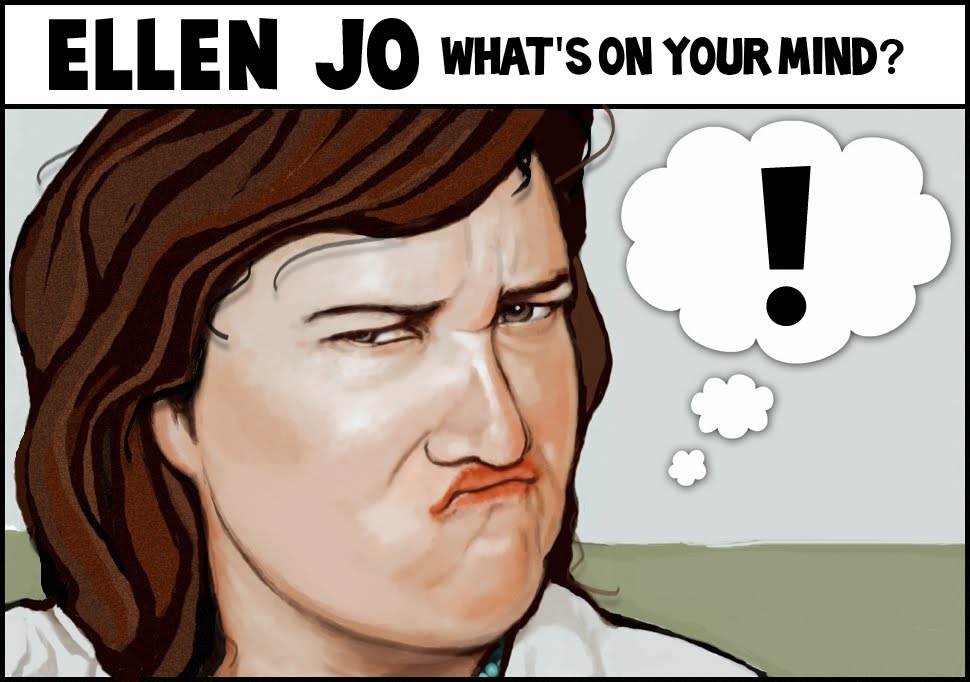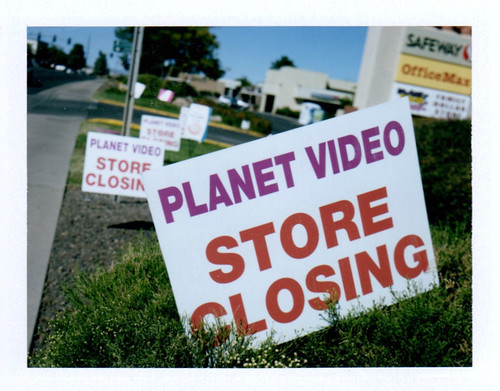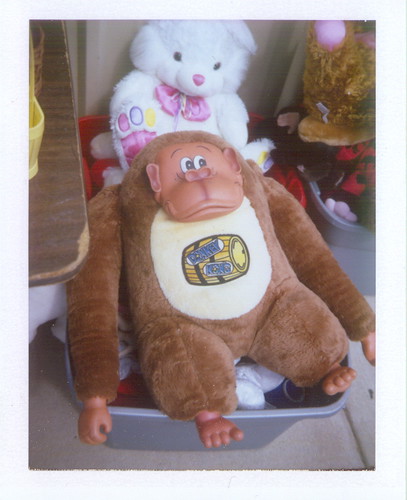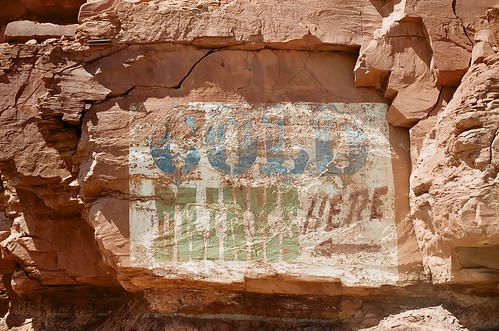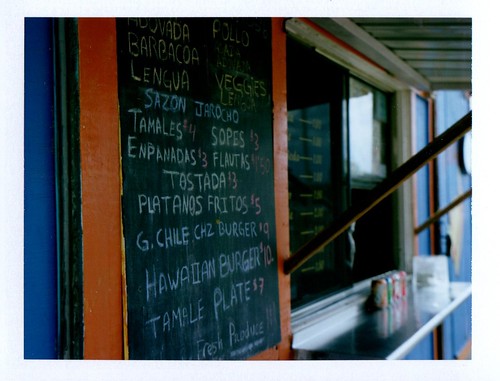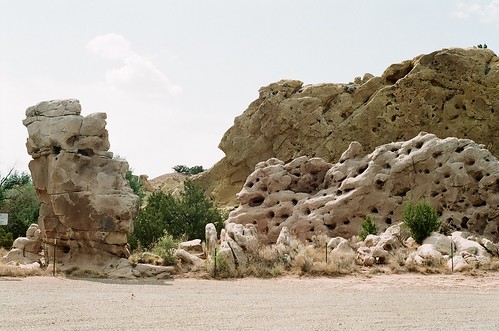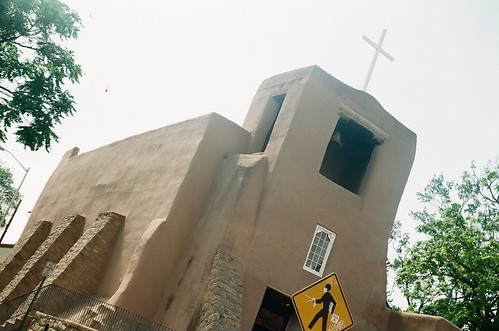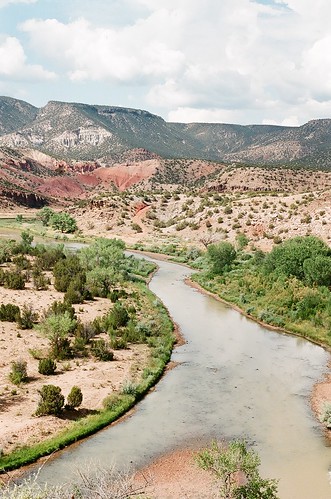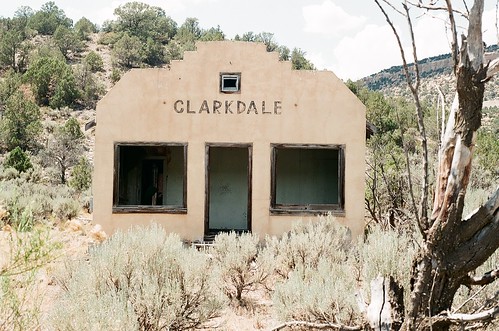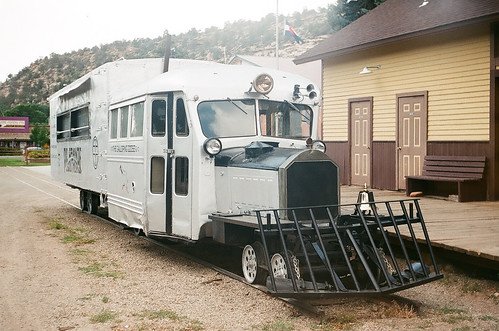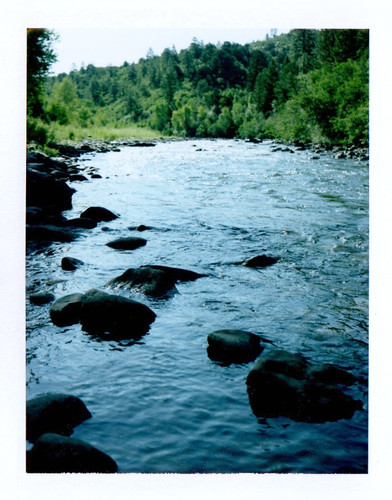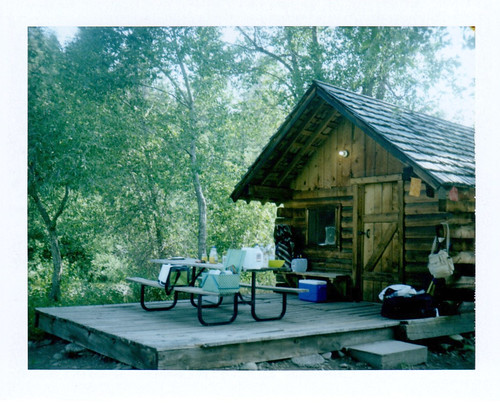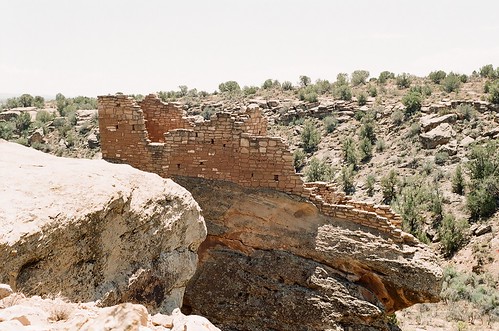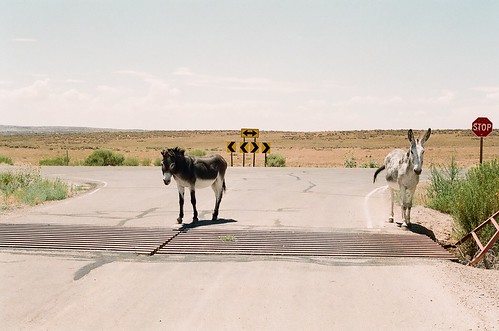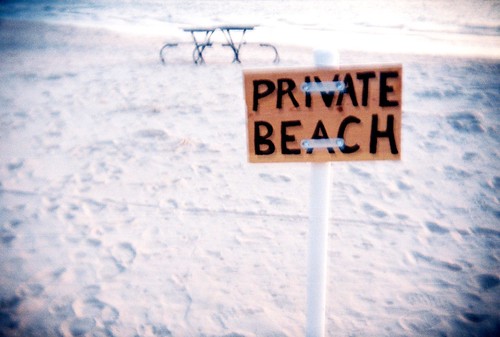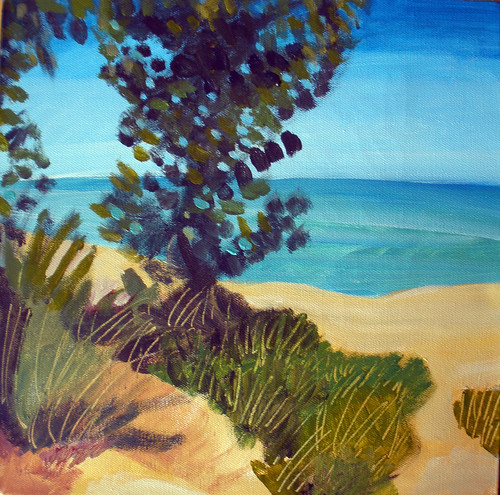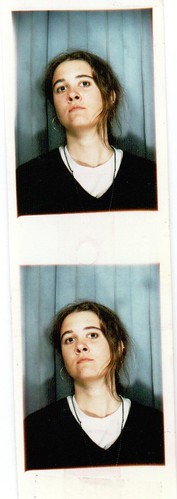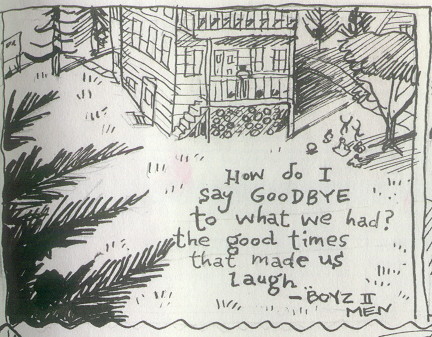Random
Western Wanderings.
In
This Episode: Hot Springs and The Thing!
The
Noise- January 2014
The
Outs
Ellen Jo Roberts
Greetings from Truth or Consequences, New Mexico, a
dusty old town on the banks of the mighty Rio Grande.
Western New Mexico seems far away, no matter where you’re coming from. As one friend put it, it is the ideal place for felons to disappear forever because, like, who’s gonna look for them here? This road trip took us along hundreds of miles of two-lane blacktop, past never-ending forests of roadside yucca, through ghost towns and over corkscrewing mountain passes. Along the way we stayed at historic motels, wandered art districts, met interesting folks and made careful observation of the ways Arizona and New Mexico are similar and yet so very different.
Western New Mexico seems far away, no matter where you’re coming from. As one friend put it, it is the ideal place for felons to disappear forever because, like, who’s gonna look for them here? This road trip took us along hundreds of miles of two-lane blacktop, past never-ending forests of roadside yucca, through ghost towns and over corkscrewing mountain passes. Along the way we stayed at historic motels, wandered art districts, met interesting folks and made careful observation of the ways Arizona and New Mexico are similar and yet so very different.
After exiting I-40 at Holbrook we were the only car
on the road most of the way to Glenwood. With Gila National Forest all around,
the interesting ghost town of Mogollon to the northeast (home of the Winter Sun
family’s Super Salve Company) and the San Francisco Hot Springs just south,
Glenwood is a historic community with a small stretch of business butted up to
a slow curve of Highway 180. The monsoon season hit the southwest big last
summer. Arizona rains were relentless and in New Mexico it was no different.
Glenwood’s main tourist attraction, The Catwalk National Recreation Trail,
sustained heavy damages from flooding and remains closed until further notice.
Named for an elevated pipeline frame, a relic of the mining era hugging the
canyon walls above the Whitewater River canyon, the Catwalk was a popular
trail, and its closure has impacted tourism in the immediate vicinity.
We were the only guests checked into a strange old roadside motel. The furnace made sounds like a cat purring. The room was a wild cacophony of textures: wood paneling, rock walls, shag carpeting. Lots of different out-buildings and random artifacts littered the property, including assorted ice cream freezers and a vintage Schwinn Stingray. Stairs to the motel’s second floor had fallen away or been removed. The people in Glenwood were pleasant but I’d not say they were overly friendly. They regarded us as though we were French people on holiday rather than their neighbors from the state next door.
We were the only guests checked into a strange old roadside motel. The furnace made sounds like a cat purring. The room was a wild cacophony of textures: wood paneling, rock walls, shag carpeting. Lots of different out-buildings and random artifacts littered the property, including assorted ice cream freezers and a vintage Schwinn Stingray. Stairs to the motel’s second floor had fallen away or been removed. The people in Glenwood were pleasant but I’d not say they were overly friendly. They regarded us as though we were French people on holiday rather than their neighbors from the state next door.
Heading south from Glenwood you soon pass the San
Francisco River and the trailhead to its hot springs pools, also scoured by the
summer floods but being rebuilt according to locals.
Further down 180, you meet up with the Gila River and a ridiculous number of towering yucca, saluting you from the hillsides like their California cousin, the Joshua Tree. Silver City arrives somewhat suddenly, a surprisingly big city in the otherwise lonely wilds of southwestern New Mexico. Born from a 19th century mining boom, Silver City is a perfect size town—large enough to offer some engaging culture and diversity but small enough to still be considered “charming”. It’s got the perfect blend of appealing features: bountiful art galleries, crazy mannequins and cool 20th century downtown architecture, all of it fringed with beautiful wilderness and just enough seediness to make it a “real” place.
Further down 180, you meet up with the Gila River and a ridiculous number of towering yucca, saluting you from the hillsides like their California cousin, the Joshua Tree. Silver City arrives somewhat suddenly, a surprisingly big city in the otherwise lonely wilds of southwestern New Mexico. Born from a 19th century mining boom, Silver City is a perfect size town—large enough to offer some engaging culture and diversity but small enough to still be considered “charming”. It’s got the perfect blend of appealing features: bountiful art galleries, crazy mannequins and cool 20th century downtown architecture, all of it fringed with beautiful wilderness and just enough seediness to make it a “real” place.
Silver City’s Main Street is actually 65 feet below grade, sunken into a rocky wash now referred to as The Big Ditch. The town’s original dwellers foolishly chose this frequently flooded thoroughfare as their Main Street. The business owners kept rebuilding after each flood until the “big one” struck, in the summer of 1895. Now Main Street is better known as Big Ditch Park, where the lazy trickle of San Vincente Creek contentedly rolls over the rocks below.
From Silver City it’s a wild, winding drive on Highway 152 over the Mimbres Mountains, the Black Range and Emory Pass to arrive at our turnaround point on this random roadtrip, Truth or Consequences. The constant switchbacks and hairpin curves totaled less than 35 miles, but added 90 minutes to our drive time.
Dropping down into the valley below the pass, Kingston and Hillsboro are two historic mining communities, both part ghost town and part alive with Hillsboro being the more vigorous of the two.
By the time we pulled into Truth or Consequences, it was after dark and I was road weary from driving those relentless curves. We had reservations at a nifty lil’ restored motorcourt a few blocks from downtown. The owner of the motel was also a cranial-sacral specialist and she had an intense, hypnotic gaze I later found to be symptomatic of the city and similar to the New Age open-faced spiritualism conjured in Sedona. The people of Truth or Consequences are frequently involved in some sort of healing arts, no matter their day job, and their penetrating expressions seemed to be trying to bore right into my soul. Or, maybe they were alien visitors from another planet. Either way, fine with me. I’ve got nothing to hide.
Truth or Consequences (or “T or C” as called by the
locals because the full name is such a mouthful), is a small city in Sierra
County, built atop a deep reservoir of mineral hot springs that generate a flow
of 2.5 million gallons per day. The Chiricahua Apaches deemed these hot springs
sacred, calling them by the name “Place to Pray”. In the 1930s and 40s it was
known as a health spa town, full of bathhouses and masseuses. The Rio Grande
frames the edges of the town, gathering stream and steam from the hot springs
as they join it upon exit from the assorted bathhouses.
The Hot Springs Historic District congregates close to the river. During its pre-World War II heyday there were more than 40 bathhouses in town, and a “21 Day Soak” regimen was touted to cure anything that ailed you.
Today a collection of ten active and open-for-business bathhouses dot the neighborhood. They range from expensive upscale to vintage downtrodden but all are piped with the same mineral-rich water ranging from 98-115º degrees Fahrenheit. The springs are not sulfury, so the volcanic smell familiar with hot springs in other regions is absent in these baths. Instead, 37 different minerals bubble up from the earth, including Lithium, a “natural mood balancer.” After a soak in these magical, slightly salty waters, we did feel younger, calmer, more limber. The public baths we visited were perched right at the edge of the Rio Grande. From our 104º soak, we watched the sun set over Turtleback Mountain in the distance and imagined the olden days, with early visitors camped in tents and slathered in mud to cure their rheumatism.
The Hot Springs Historic District congregates close to the river. During its pre-World War II heyday there were more than 40 bathhouses in town, and a “21 Day Soak” regimen was touted to cure anything that ailed you.
Today a collection of ten active and open-for-business bathhouses dot the neighborhood. They range from expensive upscale to vintage downtrodden but all are piped with the same mineral-rich water ranging from 98-115º degrees Fahrenheit. The springs are not sulfury, so the volcanic smell familiar with hot springs in other regions is absent in these baths. Instead, 37 different minerals bubble up from the earth, including Lithium, a “natural mood balancer.” After a soak in these magical, slightly salty waters, we did feel younger, calmer, more limber. The public baths we visited were perched right at the edge of the Rio Grande. From our 104º soak, we watched the sun set over Turtleback Mountain in the distance and imagined the olden days, with early visitors camped in tents and slathered in mud to cure their rheumatism.
Advertised as the “City of Health” and “Health
Capital of the Southwest” the name of this place was actually Hot Springs, New
Mexico until 1950. In 1949, Ralph
Edwards of the radio (and later television) show “Truth or Consequences”
announced a stunt to celebrate the show’s 10th anniversary. They
wanted a town to volunteer to change its name, in exchange for publicity and
exposure in connection with the very popular show. Many towns entered the
contest, but Hot Springs was deemed the champ. The premise of the long-running
(1940-1978) game show involved challenging contestants with impossible trivia
questions. Failure to answer correctly before the buzzer rang meant the
contestants must instead complete some wacky, humorous stunt. In addition to
having a town in New Mexico take its name, Truth or Consequences was also
notable for being the very first game show ever shown on television, in an
early broadcast in 1941 when the medium was in its infancy.
Another surprising way Truth or Consequences is
first on the cutting edge: Commercial space travel. Spaceport America is a
“gateway to space” and "the world's first purpose-built commercial
spaceport". Located 20 miles east of T or C in the Jornada Del Muerto
desert basin, the Spaceport is now open and operational. Construction began in
2006 though the concept dates back to the early 1990s. Several tenants call it home, but its
keystone is certainly Sir Richard Branson’s Virgin Galactic, the first
commercial spaceline. Virgin Galactic has already succeeded at launching 20
space missions from this location, suborbital test expeditions to the outer
reaches of the earth’s atmosphere, 60 miles sky high from sea level.
T or C is a weird town, but in a fun way. The people, with their warm sincerity and crazy soul-searching stares certainly make an impression. Just like Arizona, there is a great blend of cultures: Native American, Mexican, crusty old cowpokes, musicians, artists, hippies and transplants new and old.
The downtown shopping district is a cool scene of classic kitsch and dusty old western style. T or C’s main grocery store, Bullocks, probably hasn’t changed much since the 1980s and reminded me of the neighborhood grocery store of my childhood with its rubber entry mats prompting the entry and exit doors to open separately, its low ceilings and cluttered aisles. I knocked over an entire display of Pepto Bismal and no one batted an eye.
New Mexican towns never have as many trees as
Arizona towns. I always feel a bit windswept and sun-parched in New Mexico.
Though New Mexico is very much like Arizona, geologically and historically, I
was vexed to discover there are people in The Land of Enchantment who do not
consider themselves fans of their neighbor to the west. We have traveled to New
Mexico often in the past year and a general, jovial camaraderie from fellow
western folk is something we have savored. On this most recent visit I was
stunned by a conversation with a particularly strident employee of a bathhouse.
“I am enjoying Truth or Consequences,” I said with a
smile, all positivity and light, trying my hand at hypnotic expressions, “I’m a
fan of towns of the west and this one is surprisingly artsy and very
interesting.” Despite my warm fuzzies, she was instantly dismissive, frowning,
saying T or C “lacks culture”, and
then hit me with this sucker punch from behind her work desk:
“I’d NEVER go to
Arizona.”
Because of our horrible governor and her politics. And how our
horrible governor was influencing the behavior of their slightly less horrible
governor. I felt all the air escape from my lungs. I don’t think she realized
how insulting she was being. I’m no fan of Jan Brewer so to paint the entire
state and all of its residents with the same brush you’d use on the governor
seemed absurd to me. How could she not see the irony of her prejudice? Besides
that, she really harshed my mellow after a nice mineral soak. I kept going on
and on about it as we headed back to the motel, to the point Chad finally said,
“I wish you’d NEVER even TALKED to that woman.”On the ride back we continued in a loop, following a southern route, interstate quick, along I-10 back to Arizona. Hatch, New Mexico is well known as the Chile Capital of America, but did you know it’s also the Capital of Colossal Fiberglass Figures?
Along the interstate, famous billboards tout the rapid approach of something called “The Thing”. “The THING! WHAT IS IT?” Building to a crescendo with every passing mile, these roadside teases did their trick on me, “Oh, we’re stopping. At THE! THING! We must find out, WHAT! IS! IT?!”
The Thing is located near Willcox, right off the
interstate. It’s a gas station, a fast food pit stop, a gift store. And it’s
also a crazy, amazing, creepy collection of the American bizarre! For only
$1.00 entry fee (75 cents for kids) you can stroll through three big steel
sheds stocked full of insane artwork, machines and autos, questionable
artifacts, dusty mannequins, rain damaged furniture and unintentionally
humorous displays. My favorite? A 19th
century telephone in a glass case, sitting next to a 1950s rotary phone. The
words above the two phones, “Ma Bell, My How Far You’ve Come!” (Ma Bell, you
have no idea!) As for “The Thing”? What
was it? Well, I can’t say. Maybe a mummy, maybe a dummy. Chad thought it was an
alien. I took no photos while strolling the collections at The Thing, because I
believe every American should pay a visit and see for yourself. It’s only
$1.00.
Ellen Jo Roberts lives in Clarkdale AZ with Chad, Floyd,
Ivan, Ned and Hazel. Read all about it at ellenjo.com
.
